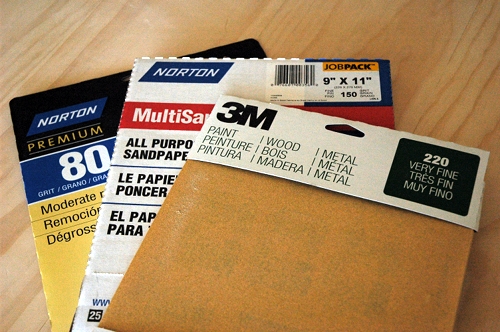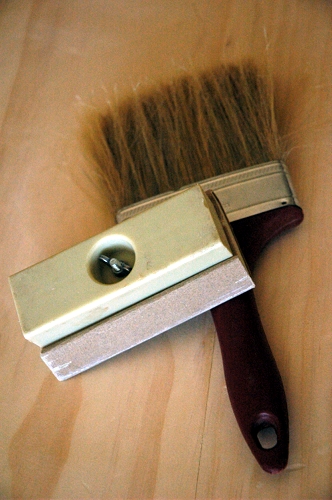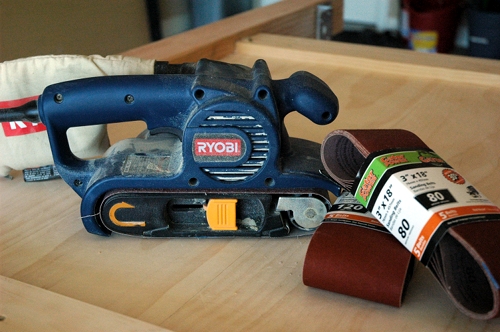Okay, so maybe not everything. If you are a master carpenter, you should probably just move on to the next topic in your Google Reader. However, if you are just an average DIY guy or gal like me, perhaps I can help.
Sanding is one of the DIY tasks that I really despise, but it is absolutely necessary. To make the job move a little quicker, I taught myself a few things about the process and materials so that I could sand more effectively.
Sandpaper Grits and When to Use Each One
As you’ve seen in your local home improvement centers, sandpaper comes in a vast array of grits. The larger the abrasive material that’s glued to the sandpaper, the more coarse the paper and the lower the grit.
Generally, I have found that there are four ranges that I use when working on wood projects:
- 80/100 – Coarse – Use these grits when you are removing a previous finish from a project (like sanding off paint) or if you are working with wood straight from the lumberyard or home improvement center;
- 120/150 – Fine – Use these grits for sanding bare wood in preparation of finishing;
- 180/220 – Very Fine – Use these grits for sanding bare wood right before finishing;
- 240 – Ultra Fine – Use this grit in between poly and other clear finish coats.
There are also “microgrits” – those that go above 240. They are used for polishing metals and for sanding wood when you need a super-de-duper glass smooth finish. I think they go up as high as 3000.
You may wonder why the descriptions for “Fine” and “Very Fine” are essentially the same. That is because you need to take a step down approach with sandpaper. If you start with a “Coarse” paper, you should then use the “Fine” and “Very Fine” before you get to “Ultra Fine.” Skipping a range will make it difficult to get to the smooth finish you desire, as it will take you much longer to get down to that finish.
When the sandpaper you are using no longer feels rough to the touch, it’s time to use a new sheet. Don’t skimp on sandpaper and try to use it until it rips. Your project will sand much quicker if you change out the sandpaper often.
Sanding Tools
Other than sandpaper, there are a few tools that you will need. At the very least, you need a sanding mask and safety glasses. You really don’t want the sanding dust (the leftover grit and wood debris) to get in your lungs and eyes. PLEASE wear a mask and glasses.
The next level of items you will need are a sanding block and an old paint brush. Instead of buying the sanding sponges that come in different grits, I recommend buying a plastic block that you can fit to your own sandpaper. You can buy one package of flat sandpaper instead of a bunch of different sanding sponges. In my experience, the flat sandpaper lasts longer than the sanding sponges anyway. The old paint brush is used to brush the sanding dust off of your project.
The third thing I’d recommend is a finish sander. This tool is easy to use and makes sanding go faster than just sanding by hand. They are inexpensive (mine was under $40 at Lowe’s) and they use a 1/4 sheet of the flat sandpaper that you already use. If you can only afford to buy one sander, get one like this. When sanding, you’ll want to move the sander in different patterns (figure 8s, circles, etc) instead of just going back and forth since it doesn’t make a random orbit.
If you are super fancy and want to buy two sanders, you’ll also want to get a belt sander. The reason why you don’t want to ONLY have a belt sander is that it requires sanding belts. You generally won’t be able to find sanding belts finer than 180 at your local home improvement center, so you won’t be able to use the belt sander for any sort of finish sanding. You can find finer sanding belts online, but you would really have to plan ahead for your projects (and hope that you order enough that you don’t run out).
This baby has a lot of power and will require two hands to hold it. However, you will be able to sand your project so much quicker than using just a finish sander. Honestly. You will be blown away at how quickly it goes with a belt sander. We have this Ryobi model from Home Depot, and it cost about $50.
There are several other types of big boy (or big girl) sanders that cost more, but I’ve never felt the need to have any of those.
What else do you want to know about sanding? Let me know and I’ll try to answer!
P.S. Have big plans to improve your home this summer? From now until August 14, visit TheBagsterProject.com to enter Waste Management’s The Bagster ® Summer Home Improvement Project Sweepstakes for a chance to win $10,000 to put towards your home improvement project.
NO PURCHASE OR USE OF BAGSTER NECESSARY. Void where prohibited. Open to legal residents of the 50 U.S., D.C. or Canada (except Quebec) who are, as of Entry, 21 years of age or older. Promotion starts at 12:00:01 AM (ET) on 6/20/11 and ends at 11:59:59 PM (ET) on 8/14/11. Click here for Official Rules. Sponsor: WM Bagco, LLC.




Nice summary. THanks for sharing!
Great info, thanks! What do you use the belt sander for? Is it appropriate on smaller areas like chairs or more for large, flat areas like tables and bookcases? Thanks!
Hi Lulu- Yes, it’s for large, flat areas, like tables, bookcases and dressers. Those pesky chairs you usually have to do by hand.
wonderful! thank for the sandpaper info and the giveaway info! I’m in need of both!!
do you think the same ‘rules’ would apply to dry wall? both for hanging new and sanding before painting? (am I the only crazy that does this? most of the walls in our hosue need a god sanding before painting because of the previous owner leaving drips on the wall and I believe using outdoor/ concrete high nap rollers on the walls….)
I have no idea! I’ve never sanded “old” drywall before. Sounds like the previous owners did a number on your walls!
I would love you to delve a little more into masks. I bought a cheaper one, but it is killing me to wear when it’s 107 degrees outside (you shouldn’t refinish furniture in Texas in the summer, but I can’t control when my daughter decides to crawl out of her cirb…) I have heard the ones that look like gas masks are much better…thoughts?
Yeah, I’ve used both kinds. Personally, I find the gas mask kind warmer in this ridiculous Texas heat, so I’ve been using the cheaper kind this summer. I really think it’s a personal preference, although I do think the gas mask kind actually work better.
If you really want to splurge, get a Festool one. http://www.festoolusa.com/accessories/sanders.html?compatibility=571817
They are pricey but can be used inside (out of the heat) as they have a vacuum attached. Have used my husband’s to help him on job and LOVE it. Big perk…he doesn’t snore at night when he uses it.
Okay, *that* is super cool!
This is all good to know! Going to Pin it in my DIY file. 🙂
do you need to use protection when you sand in water at grit 600 and up ?
Hi Janis-
Wet sanding keeps the dust to a minimum, so you don’t *have* to wear eye protection and a mask. But, it all depends on what you are sanding. Wood? You’re probably fine (but why risk it?). Metal? Definitely wear the mask. My grandfather is a retired machinist with chronic lung problems, and we are convinced it was all of the metal dust he breathed in over the years that has caused his problems.
I would also add an orbital sander to the mix and wetting the wood with a damp cloth between sanding (letting it dry completely) to raise the grain since sanding compresses it. I usually use 80, 120, 180 and 200.
Also a respirator too! and more cartridges as they do only last about a day or less. I would also sand with the grain, and not do any circles or figure 8’s as you can see it in the wood.
experience- BFA in find woodworking and furniture design
I really hate sanding, too. It only took one poorly sanded project, though, to learn how important it is. Thanks for the tutorial on sanding — my finish sander is one of my favorite power tools (and one of the best birthday presents I’ve ever gotten, too)!
Great info! Thanks for sharing.
I loved reading your article and was impressed with your sandpaper knowledge. I also really appreciated that when you showed a picture of your belt sander that you showed Gator Finishing Sanding Belts, big thumbs up. Have you used Gator and what do you think of it? If youd like to try some other Gator sandpaper, let me know know. we have other awesome sandpaper that, in my opinion, work longer, better and quicker then Norton and 3M.